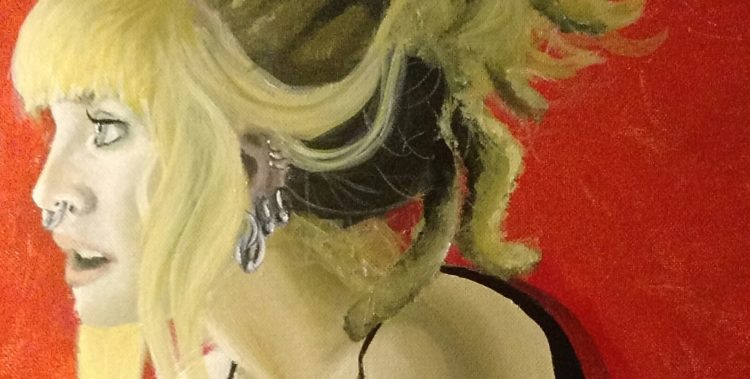
Brianna Ballinghoff
First step: taking a photo. I’m going to do a full-body shot. I’ll do it crouching on top of my table with an orange curtain draped behind me. I set up light sources to make interesting shadows and highlights—I want it to be fun to draw. Then I have someone take a few photos. Something’s not quite right with one of the lamps, so I move it. Perfect. The plan is to stay true to this photo.
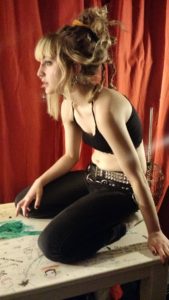
I do a sketch to get a feel for it. This helps me decide what I like, what I should focus on, what I should change. I want to exaggerate my proportions while at the same time keeping them believable. Something surreal.
The composition isn’t quite right. There’s something missing. I’m thinking about weight. Not my physical weight, but where I feel something pushing on me. The spots on my body where I feel pressure. My back issues. In the sketches, I add a bunch of objects to my hair, tangled up. Things that are always weighing down on me, like time and money. When I’m drawing, I put so much pressure on my back. It worries me, but I’d rather make it easier to do art than work with good posture. In the sketch, I’m hunched a little further.
Now I start with the canvas. I use charcoal and a kneaded eraser. I want to get a good shape down first, rather than letting the paint control the shape later on. When I’m thinking, I play around with the eraser. It takes down my stress. I push the charcoal into the canvas until there’s nothing left. I don’t want any to go to waste. I’m thinking about all these things in my hair. They’ll be tedious to paint—I’m not looking forward to it—but they’ll make the piece more meaningful.
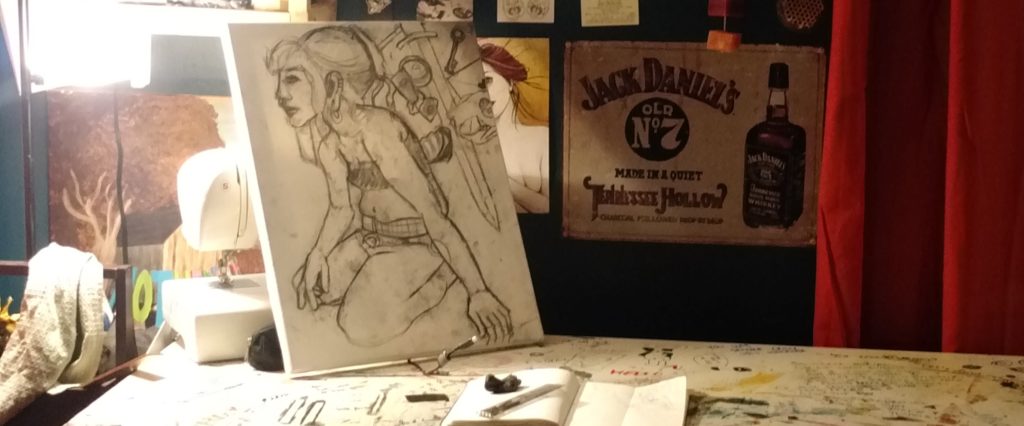
It’s funny: I was putting symbolism into the painting about how time always weighs on me, but now I realize that I wasn’t thinking about time at all while I was doing this. I feel energized.
The next day, I’m feeling down. School has me working on things I’m not comfortable with. I’m hoping to become a tattoo artist, but I’m a painter at heart. This means I’m not very neat, whereas tattooing is about cleanliness and how straight your lines can be. It’s 9:30 p.m. and I come back to my self-portrait with a sense of relief, because this is something I can do.
I work on the face today. It’s hard. As I draw my ears, I think about how now that I’m doing piercings, I know way too much about ears, and I include the details I never would have seen before. It takes forever to get the eyes correct. The eyes are so important because if you mess up even an eyelash it’ll be a different person. When the face is finished, I realize my head is way too big. I need to fix it, but I’ll redo the body instead of tampering with the face.
While I work, I forget about my worries from today. Not that I’m totally secure. I’m drawing my skin, and it’s bare. I’m always thinking about how bare my skin is. If I’m going to be a tattooist, will people take me seriously? Being a scrawny female doesn’t help.
At some point my dad comes in. “You forgot to include that crooked part of your nose,” he says. Hearing something like that is better than hearing someone say you’re beautiful. I like the thought that the quirks about you can be endearing to someone else.
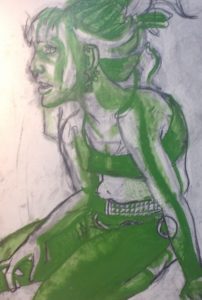 With the underdrawing finished, I spray it with matte so that the lines don’t bleed into the paint. I do the underpainting in green, because it will look good with the orange background. I look like a zombie—pretty cool. Watery layers, and more layers. I think about how many different tones there are in your skin if you really look. I refer to the photograph as I do this, to get the contours right. I don’t look at the sketches at all and won’t anymore.
With the underdrawing finished, I spray it with matte so that the lines don’t bleed into the paint. I do the underpainting in green, because it will look good with the orange background. I look like a zombie—pretty cool. Watery layers, and more layers. I think about how many different tones there are in your skin if you really look. I refer to the photograph as I do this, to get the contours right. I don’t look at the sketches at all and won’t anymore.
I’m using acrylic paint, the expensive kind. I use cheap paintbrushes because I’d rather spend my money on paint. Good paint is thicker and spreads better. Sometimes the brushes work against me, but whatever. I’m refining and rendering the layers. Sometimes I’m just blotting with an empty paintbrush, trying to blend it just right.
I’m getting rid of the objects in my hair. I realize now that it’s not important. It felt forced. I was trying to add meaning, but sometimes things don’t need extra meaning. I will let my body language express those things, rather than having them literally be there.
I think about how crazy it is that artists paint themselves in the first place. Who was the first person to ever do it? I wonder how the public perceives people that draw themselves. They might think it’s just being narcissistic, but I think it’s a time to evaluate yourself and figure out yourself. Sometimes you don’t even realize what you look like until you paint yourself.
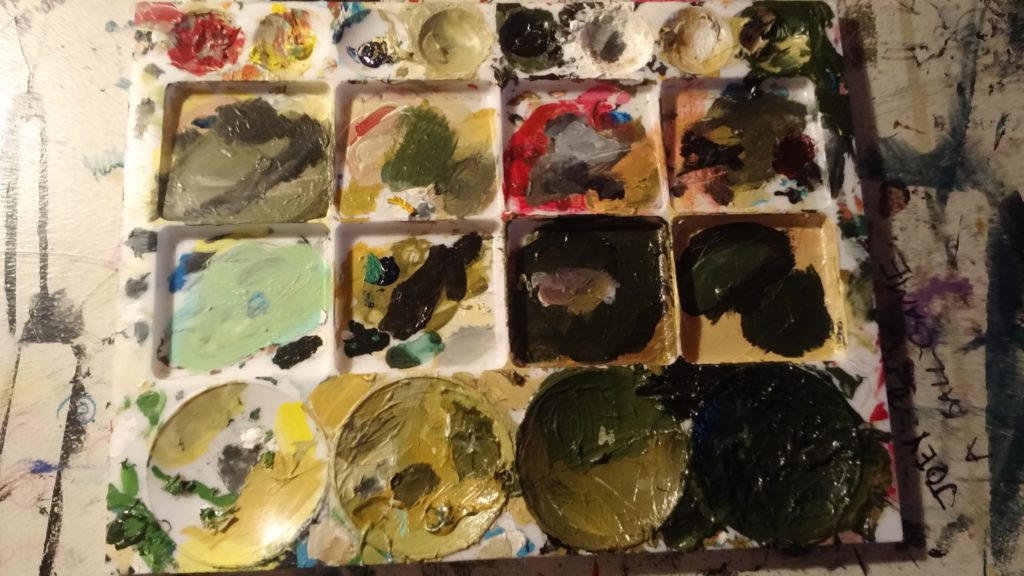
By the time I’m ready to stop, it’s 1:45 in the morning. There were a few times when I thought I’d stop before, but I didn’t want to waste paint so I thought I’d do one more little thing, and then I got more energy and wanted to keep going. Even now, everything’s cleaned up and I still feel energized. I’ll probably be up another hour watching YouTube, and I’ll regret it in the morning because I like to get up early but I won’t be able to. I wish I could paint in the daytime, but I just can’t. I just sit there drinking coffee thinking about doing it instead of actually doing it.
Suddenly the painting has been sitting for two weeks. It’s looking really good and I want to see it done, but I’ve been putting it off. I have other stuff coming up and I need to get this done, so I start working in the daytime this time.
The face is fine, so I avoid that area. Today I focus on the frustrating parts: the other body parts, the stuff I don’t have fun with. The hands especially. I have to make the colors out of every single paint color. One section dries and it doesn’t match the rest so I have to redo it, but it’s okay. I’ll finish it later.
Now I finish the hair. I work hard on it, but it doesn’t take too long. It’s funny how, somehow, dark green makes blonde hair.
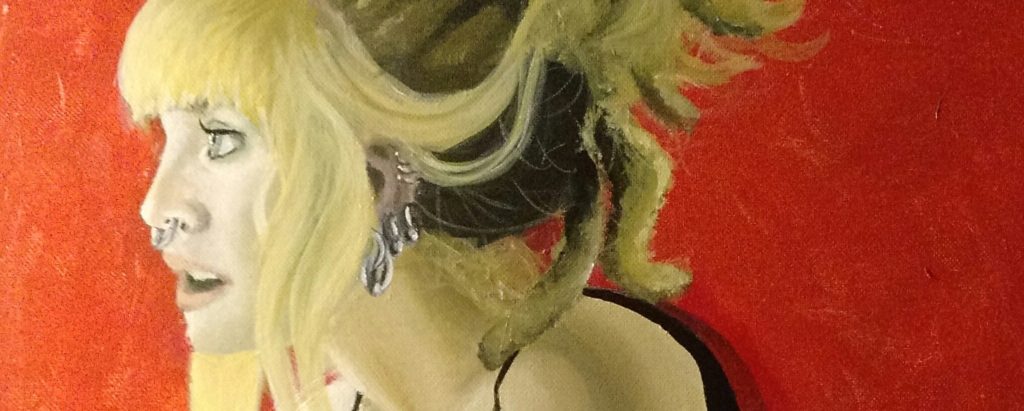
Sometimes I feel guilty about working so closely to the photo. I’m doing my own interpretation of it, adding my own color theory, so I don’t know why I’m feeling guilty, but there it is.
I’m antsy the whole time. This is why I don’t like to work in the day, because I’m always thinking about the next thing I have to do. I’m hurrying, and I keep thinking about how much paint to pour. I don’t want to waste it, and I’m already running low. These tubes are $7 each and this one I’m using has like no paint left.
Before I leave for work I take a picture and post it on Instagram. It gets a lot of likes so I feel confident, like at least I’m good at something. Even when it’s frustrating, it’s nice to be able to take a step back and look at what you’ve done, and see there’s no reason to stress out.
I buy new paints, and a week later I’m finishing this piece up. I have to finish the hands because last time I was too frustrated to work on them. I get frustrated again. This is very hard. And when I think I’m done, I realize they are way too big. It bothers me, but at the same time I like the distortion.
To prevent having to remake colors and try to match parts that already dried, I spray water over the paints on my palette and cover them with plastic wrap. That way I can have a lot prepared and not worry about it drying on me.
I refer to the photo as I work. Sometimes it’s frustrating to try and match it. Painting the studded belt, for example: There are at least 20 studs that have to look the same, but at the same time they are reflected differently. Every time I try to replicate the photo, it looks sloppy, so in the end I do my own thing. I imagine where the light should hit and paint it that way. I don’t worry about matching the photograph anymore—I just want to do what will look good in the painting.
Now I work on the background. It’s the last step because I hate backgrounds. That’s why I’m going into tattooing. So in the painting, I’m not anywhere—it’s just color. I use big brushes now. I’m careful not to touch anything else because I don’t want to have to redo anything at this point.
I step back a few times as I work today, even though it’s too late to make any drastic changes. Sometimes I get frustrated, but stepping back gives me perspective: I can work out the problems that arise.
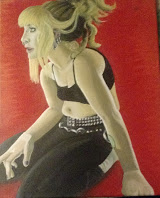 I work for a few hours in the daytime. Then I go to work and come back, and spend about four more hours finishing up. That gives me two good looks at the painting over the course of the day, and I feel pretty good about it.
I work for a few hours in the daytime. Then I go to work and come back, and spend about four more hours finishing up. That gives me two good looks at the painting over the course of the day, and I feel pretty good about it.
I’m still not quite sure if it’s done. Some things are never really done, but for me if I see it over the next few days and weeks and don’t have the urge to change anything big, then it’s done.
A few days later, I decide it’s done after all, so that’s where I’ll leave it.
This story was written by Tim Gorichanaz based on interviews with Brianna Ballinghoff.